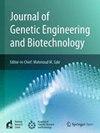Characterization of two novel chia (Salvia hispanica L.) white and black genotypes via DNA barcoding, physiological, and agronomic traits
IF 2.8
Q3 Biochemistry, Genetics and Molecular Biology
Journal of Genetic Engineering and Biotechnology
Pub Date : 2025-08-19
DOI:10.1016/j.jgeb.2025.100545
引用次数: 0
Abstract
Background
Chia (Salvia hispanica L.) is recognized for its nutritional value and health-promoting compounds, including flavonoids.
Aim
This study utilized DNA barcoding to identify and differentiate two novel chia genotypes, CACH-W and CACH-B, providing insights for breeding programs and genetic resource conservation (CA refers to the developer and CH refer to Chia).
Methods
DNA was extracted from controlled samples and analyzed using five barcode markers: trnH-psbA, matK, rpoC1, rbcL, and ITS. Genetic diversity was evaluated through phylogenetic analysis with appropriate bioinformatics tools.
Results
DNA barcoding using five markers (trnH-psbA, matK, rpoC1, rbcL, and ITS) successfully amplified sequences of 930 bp, 1520 bp, 2295 bp, 1910 bp, and 1630 bp, respectively. Among them, rbcL, rpoC1, and ITS effectively differentiated the two genotypes, and phylogenetic analysis confirmed their genetic identity and relationship with existing (Salvia hispanica L.) sequences. Functional analyses highlighted the conserved roles of key genes, including rbcL (carbon fixation), rpoC1 (chloroplast transcription), and matK (RNA splicing). The white genotype (CACH-W) outperformed the black genotype (CACH-B) in germination, physiological, and agronomic traits, achieving a higher seedling vigor index (11.68 vs. 8.51), longer radicle (6.94 cm vs. 5.02 cm), and greater total phenolic content (31.92 mg/g vs. 28.95 mg/g). Agronomically, CACH-W showed superior plant height, spike weight, and seed yield (1003.83 kg/feddan vs. 606.46 kg/feddan), making it a promising candidate for cultivation and breeding.
Conclusion
This study demonstrates the effectiveness of certain plastome gene sequences in identifying and distinguishing chia varieties, offering a reliable tool for breeding, quality control, and germplasm conservation. The white genotype (CACH-W) outperformed the black genotype (CACH-B) in germination, physiological, and agronomic traits, achieving a higher seedling vigor index, longer radicle, and greater total phenolic content. Agronomically, CACH-W showed superior plant height, spike weight, and seed yield, making it a promising candidate for cultivation and breeding. The results also support the integration of marker-assisted selection for developing chia varieties with improved traits, enhancing their commercial and agricultural value.
两种新的鼠尾草(西班牙鼠尾草)白色和黑色基因型的DNA条形码、生理和农艺性状鉴定
鼠尾草(Salvia hispanica L.)因其营养价值和促进健康的化合物而被公认,其中包括黄酮类化合物。目的利用DNA条形码技术对中国奇亚两种新基因型cache - w和cache - b进行鉴定和区分,为中国奇亚的育种规划和遗传资源保护提供依据。方法从对照样品中提取dna,采用trnH-psbA、matK、rpoC1、rbcL和ITS 5种条形码标记进行分析。遗传多样性通过系统发育分析和适当的生物信息学工具进行评估。结果利用trnH-psbA、matK、rpoC1、rbcL和ITS 5个标记分别扩增出930 bp、1520 bp、2295 bp、1910 bp和1630 bp的dna序列。其中rbcL、rpoC1和ITS有效区分了两种基因型,系统发育分析证实了它们的遗传同一性以及与现有(Salvia hispanica L.)序列的亲缘关系。功能分析强调了关键基因的保守作用,包括rbcL(碳固定)、rpoC1(叶绿体转录)和matK (RNA剪接)。白色基因型(cache - w)在发芽、生理和农艺性状上优于黑色基因型(cache - b),幼苗活力指数更高(11.68比8.51),胚根长(6.94 cm比5.02 cm),总酚含量更高(31.92 mg/g比28.95 mg/g)。从农艺上看,hach - w在株高、穗重和籽粒产量上均有显著优势(1003.83 kg/feddan vs. 606.46 kg/feddan),具有良好的栽培育种前景。结论本研究证实了某些质体组基因序列对奇亚品种的鉴别和鉴定是有效的,为奇亚品种的选育、质量控制和种质资源保护提供了可靠的工具。白色基因型(cache - w)在发芽、生理和农艺性状上优于黑色基因型(cache - b),幼苗活力指数更高,胚根更长,总酚含量更高。在农艺学上,hache - w表现出优异的株高、穗重和种子产量,是栽培育种的理想选择。这一结果也为整合标记辅助选择来开发具有改良性状的奇亚品种,提高其商业和农业价值提供了支持。
本文章由计算机程序翻译,如有差异,请以英文原文为准。
求助全文
约1分钟内获得全文
求助全文
来源期刊

Journal of Genetic Engineering and Biotechnology
Biochemistry, Genetics and Molecular Biology-Biotechnology
CiteScore
5.70
自引率
5.70%
发文量
159
审稿时长
16 weeks
期刊介绍:
Journal of genetic engineering and biotechnology is devoted to rapid publication of full-length research papers that leads to significant contribution in advancing knowledge in genetic engineering and biotechnology and provide novel perspectives in this research area. JGEB includes all major themes related to genetic engineering and recombinant DNA. The area of interest of JGEB includes but not restricted to: •Plant genetics •Animal genetics •Bacterial enzymes •Agricultural Biotechnology, •Biochemistry, •Biophysics, •Bioinformatics, •Environmental Biotechnology, •Industrial Biotechnology, •Microbial biotechnology, •Medical Biotechnology, •Bioenergy, Biosafety, •Biosecurity, •Bioethics, •GMOS, •Genomic, •Proteomic JGEB accepts
 求助内容:
求助内容: 应助结果提醒方式:
应助结果提醒方式:


